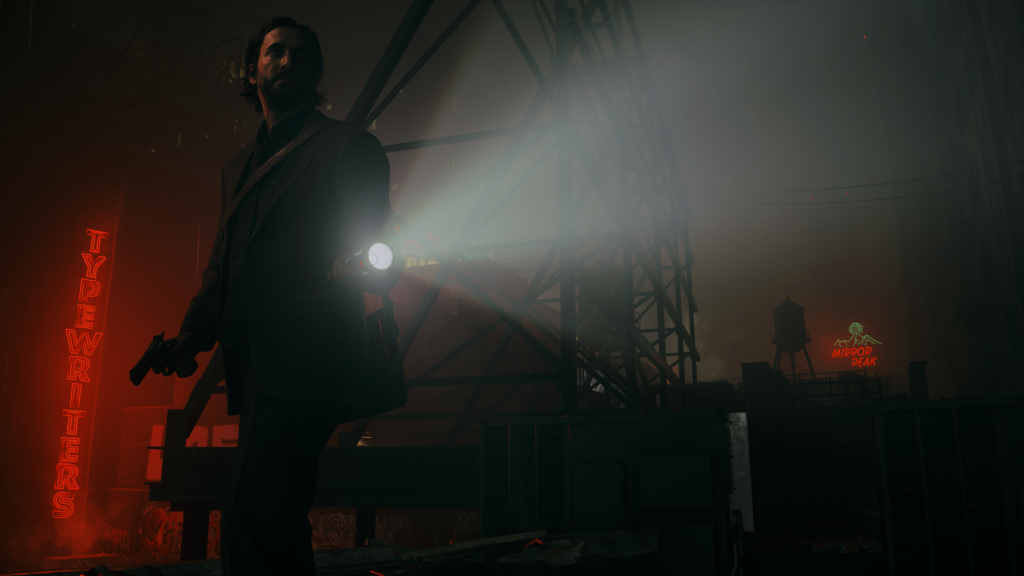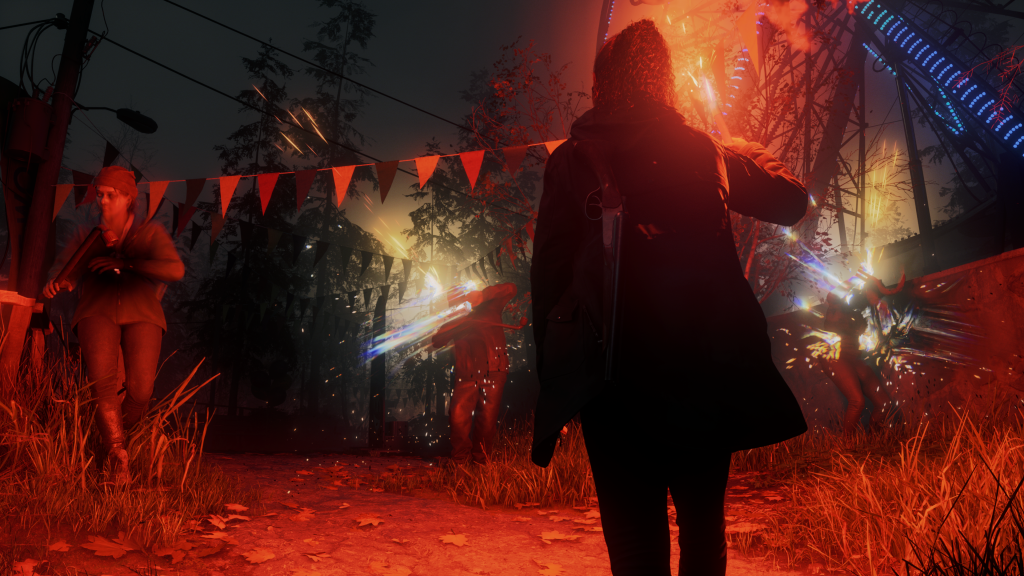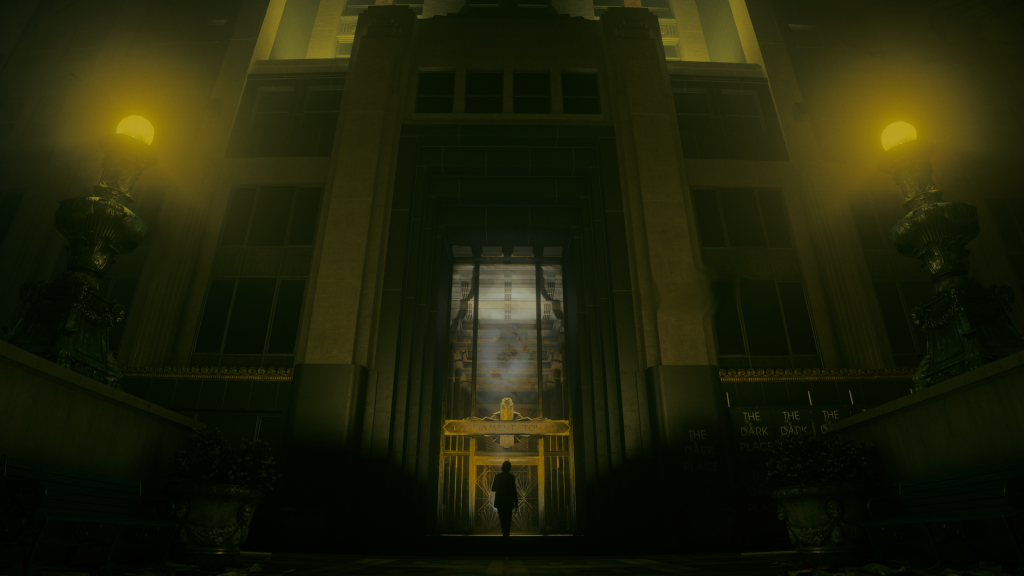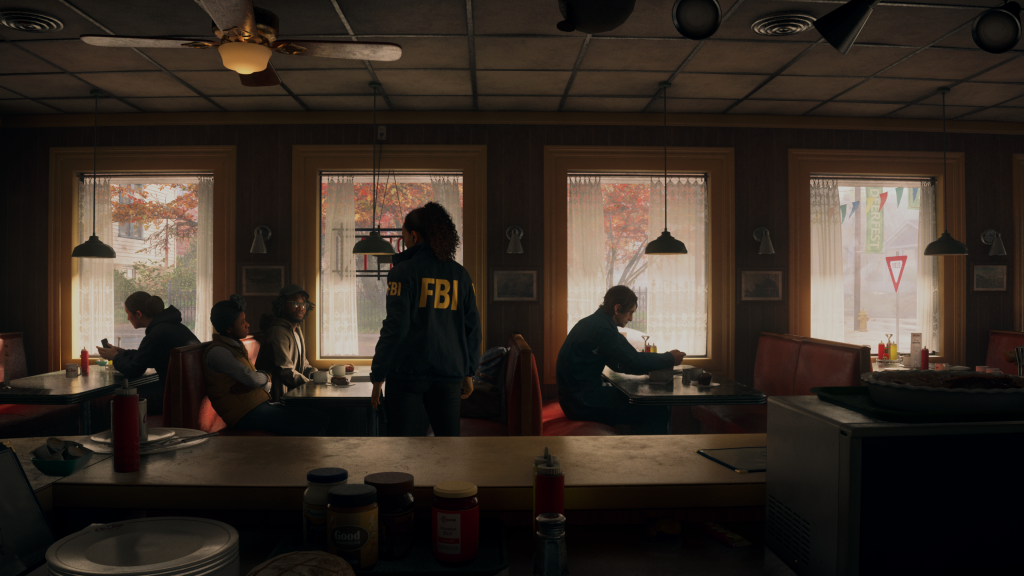Alan Wake II is insane. There’re layers upon layers of meta references buried within the spiraling madness that makes up the game. Remedy’s previous games never really clicked with me, but Alan Wake II did have my brain working overtime to decode the entangled threads of narrative that are sewn in a chaotic tapestry of nightmares. I highly value uniqueness, and the ability to push the gaming medium forward into a weird and strange direction is something that I applaud Alan Wake II for. It’s not without its flaws as there are quite a few things that I took issue with, but this is a truly bizarre game in the best way possible.

The story of Alan Wake has long been dormant. The basic premise is that the titular character, Alan Wake, is a best-selling author that gains the power to influence the world with his writing. On a trip to the remote Pacific Northwest town of Bright Falls, Alan got sucked into a horror story in which he sacrifices himself to rescue his wife from a dark presence. Alan is now trapped in a nightmarish dream reality while a doppelganger of his, called Mr. Scratch, is terrorizing the real world. In parallel with Alan’s story, a new protagonist named Saga Anderson and her partner Alex Casey arrive in Bright Falls to investigate a string of mysterious disappearances.
Saga investigates the quaint towns and the dense wilderness of the Pacific Northwest. A murder cult seems to be the cause of numerous disappearances, and she tries to deduce their goals and motives. While on the case, she learns of the dark presence and how an ever-changing horror story is coming to life. I enjoyed how the player could enter Saga’s “Mind Place” to put together the facts of the case. Her Mind Place is a cozy cabin with clues and papers strewn about. You use a big board to pin clues into place and make revelations about the plot. I do think this aspect might’ve been slightly overused, as there isn’t a ton of actual deduction or gameplay involved here. Mostly you’re just putting known pieces in place to move forward. Nevertheless, I enjoyed the noir vibes.
While Saga explores the real world, Alan is trapped in a labyrinthian nightmare. This is where things truly get weird. He wanders around an ever-shifting urban environment, rife with confusing dream logic. He’s caught in a surreal loop, desperate to escape. He has to use his abilities to write his way out of the loop. Alan visits numerous atmospherically dense locations such as a hotel, subway, and movie theater that were homes to ritualistic murders. As you explore these locations, you move pieces around on a storyboard to alter the plot and move forward. I absolutely adored how tense these sequences were. There’s a sense of dread of what you are going to see when you move a new horrifying plot element into place. One particularly haunting transformation was seeing how an ordinary hotel turned into a ghoulish scene where blood was scrawled across every wall and the hallways were strewn with gored bodies.

The seamless use of mixed media is part of what defines Alan Wake II. The transitions between game and live-action are incredibly well done and fuel the metanarrative aspects of the story. Remedy has a wonderful cast of actors that portray their characters expertly. It blurs the lines between what is real and what is dream logic. There’s a full 15-minute artistic short film that can be found which serves as a pivotal plot point of the imaginary murder cult in Alan’s dream reality. And that film uses the actor who also plays Alex Casey who is the main character in Alan’s detective novels, and that same actor also plays a different Alex Casey who is Saga Anderson’s partner in the real world. And that actor is the creative director of the game: Sam Lake. Who also plays other characters in Remedy’s expanded universe. There’re layers upon layers of references to unwind. Alan Wake II references itself, its predecessor, other games within its universe, and heavily leans on tropes from detective and horror media.
I find that media with heavy meta elements can often feel pretentious, but that’s not the case with Alan Wake II. The game knows that it can be ridiculous at times, and isn’t afraid to point this out. The writers clearly had fun with this game and they embraced the weirdness. Take for example the commercials that play on the TVs throughout Bright Falls. Two of the side characters write, direct, and star in their own goofy productions about their side businesses. Such as their coffee-themed amusement park with a moose as a mascot. I love that despite its metanarrative elements and complicated story, Alan Wake II doesn’t take itself too seriously.

Where Alan Wake II really shines is its thick atmosphere. The sharp contrast between the two protagonist’s settings created some phenomenal variety. As Saga you have to explore dense woods, small towns, and other rural locales. Conversely, Alan is trapped in an urban nightmare. Dirty streets, highrises, and buildings such as hotels dominate his perspective. Both settings are eerie. Saga wanders through thickets as cultists and possessed wolves stalk her. Shadows whisper and lunge at Alan as he navigates through nonsensical streets and corridors. Darkness envelopes both characters, and the safety provided by a break room or an abandoned hut is spirit-lifting as these are your only beacons of safety. The game’s spectacular visuals add to the sense of immersion, as Alan Wake II is a fantastic game to look at.
The gameplay of Alan Wake II was something that I was worried about. When I played the original Alan Wake I thought the setting and atmosphere were amazing, but the game was marred by an absolutely abysmal combat experience. Luckily, Alan Wake II keeps the premise of its predecessor but vastly improves upon it. To fight enemies, you need to focus your flashlight on them to break through their darkness shield. From there, it functions like a standard third-person-shooter. I quite liked how impactful all the weapons felt. The visual and auditory feedback was appropriately visceral, and enemies reacted strongly to being shot, especially if hit in a weak spot. I thought combat was fun overall, and the fast-moving enemies always kept me on my toes. That being said, there are a few issues that bothered me.

The first issue was the absolutely abysmal enemy variety. There’s only a handful of enemy types in the game, I found myself battling the same couple basic variations throughout the entire twenty-hour experience. Moreover, there is a ton of fluctuation in the number of enemies that the game throws at the player. There are times when you can go for what feels like hours without any combat, especially at the beginning of the game. And conversely, there were sections of the game that I couldn’t catch a breath because the game kept bombarding me with respawning cultists. Both of these extremes are negative. Too few encounters is an issue because it can get boring to just walk around with no threat of combat, and too many encounters kills the tension as it turns what should be frightening foes into a shooting gallery.
While Alan Wake II undoubtedly improved upon the gameplay of its predecessor, I still found it to be fairly clunky. Reloads are extremely time-consuming and easily interrupted, which is aggravating. However, I think the biggest cause of this is the camera. The over-the-shoulder camera is great for immersion, but I wish it zoomed out a tad during combat. When enemies get up close, the game feels unpleasantly claustrophobic and I had a difficult time adjusting the camera. I found myself saying “I can’t even see what’s going on” fairly often. There are also a ton of enemies that zip and teleport around, leaving me desperately rotating the camera to keep up. But as soon as the enemies were in my sights again, they just teleported away again.
Aside from the camera, I found that the environmental design also was a significant source of frustration for me. While the game looks astonishing, I found myself confused and turned around quite often. I think having a mind-bending dreamscape that intentionally causes the player to get lost is great. But there were plenty of ordinary places that just felt poorly signposted. Organic and detailed environments are great, but I felt that they got in the way of navigation. I love that there was no mini-map or objective markers, but the environment did not lend itself to intuitive pathfinding. But my biggest frustration with Alan Wake II was its dynamic resource economy.

An important aspect of any survival horror game is resource management. Having a limited number of bullets, healing items, and inventory space makes fights far more intense. Tension builds faster when you only have a handful of ammunition to dispatch enemies. Every encounter is terrifying knowing that it could deplete your resources. Alan Wake II does have limited resources, but its implementation is inelegant. It utilizes a dynamic system, doling out items based on how much the player already has in their inventory. If you’re running low on supplies, the game will give you more stuff, but if you are already rich in ammunition, you’ll get very few or no resources at all. At first glance, this seems like it makes sense as it ensures that the player never has too much or too little, but I find that this system undermines the entire point of resource management.
The point of having limited resources is the threat of running out. The helplessness of having no ammo to protect yourself. Having to explore and scavenge for resources can be anxiety-inducing. But there’s rarely any real threat of running out of resources in Alan Wake II. The game throws resources at you when you’re running low. And there’s little reason to thoroughly explore areas for more stuff because you get diminished amounts once you have a surplus. I found it frustrating that I was punished for scavenging, often opening a container to find it completely empty. Not only have I wasted my time, but I can never open that container again so I have permanently lost potential resources. Maybe it wouldn’t have been so aggravating if it wasn’t so obvious that the game is doing this.
For a game with such impeccable atmosphere, it’s a shame that immersion is so easily broken by something as simple as resource management. It’s obviously apparent that Alan Wake II is limiting your ammo once you open a container and there’s nothing in it. You can also game the system by stuffing excess ammo into your safe room box before going out to scavenge for resources. The game only cares about what’s currently in your inventory, so you can fake being low on ammo to get more. Breaking immersion is a sin in a game like this, and I often found myself pulled out of the world and into crunching numbers to determine whether or not opening a container was worth it.

Alan Wake II is a difficult game for me to judge. I can respect its artistic vision, the blending of genres, the use of mixed media, and of course how the story is open to many interpretations. But the game flounders a bit when it comes to basic elements such as combat, navigation, and resource economy. It’s tough to claim that this is a must play game when it falters at the basics. But Alan Wake II is a must play game. It’s unique. It’s innovative. And it pushes gaming forward as an artistic medium. It is for these reasons that I give Alan Wake II a 9/10. Even if its video-gamey elements are clunky, the unfaltering artistic vision of Alan Wake II makes it a can’t miss experience.